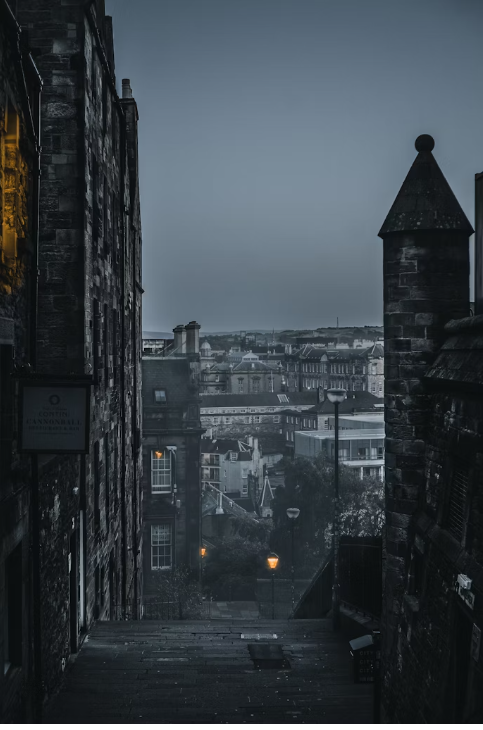Ghosts, Guising, and the Ghost-Tour: Edinburgh’s haunted economy
POSTED ON October 31, 2025 BY James Garry
Edinburgh’s ghosts walk a fine line between heritage and spectacle.
As October nights draw in, smoke drifts through the city and carved neep lanterns glow faintly in the dark. The pavements glisten after rain, the closes seem narrower than usual, and stories begin to stir in the imagination. For generations, Edinburgh has been a city that feels alive to ghosts. Our historic built environment allows one to follow in the footsteps of our predecessors through historic tenements, townhouses, closes and castles.
By the time All Hallow’s Eve arrives, the old streets hum with their retelling. Ghost tours multiply, vault doors creak open, and visitors gather to hear stories of the Mackenzie Poltergeist, the phantom piper under the Castle or the wandering souls of Mary King’s Close. It has become a familiar ritual, part of the city’s autumn rhythm. Yet, as these tales draw crowds, it is worth asking what happens when Edinburgh’s ghosts become a commodity. How much of the city’s haunted heritage survives intact, and how much has been shaped to suit the market?
In recent decades, the city’s reputation for hauntings has been energetically harnessed by the tourism industry. Ghost walks, immersive vault experiences and late-night “haunted” events are now fixtures on the tourist calendar. What began as folklore told beside the fire or the gravestone has become part of a theatrical economy. Guides mix humour, drama and local history to weave their stories, and many do so with real skill and affection for the place. But the pressure to entertain can also blur the boundary between authenticity and performance. To meet expectations, stories are often streamlined, exaggerated or combined; fear and laughter take centre stage, while quieter layers of meaning: poverty, loss, faith and survival, can be pushed aside.
The city itself bears traces of this transformation. Vaults and closes that once sheltered tradespeople or the homeless have become performance spaces, lit by torches and echoing with footsteps. Crowds file through them nightly, and while this activity keeps old places alive, it also changes their nature. What was once a lived urban fabric risks becoming a stage set, shaped by ticketing systems, lighting rigs and seasonal branding. Residents, meanwhile, find their doorways transformed into stopping points for groups and storytelling, sometimes late into the night.
These tensions are not new, but they have become more visible as Halloween’s popularity has grown. The season has ancient roots in Scotland. Long before the first ghost tour, people marked Samhainn, the turning of the year, when the boundary between the living and the dead was thought to thin. Lanterns carved from turnips flickered in windows, children went “guising,” performing songs or rhymes in return for fruit or coins, and families lit fires on hillsides to honour the dead and protect the living. These older customs were not simply about fear. They balanced mischief with reverence, and they connected people to their place and community.
In that sense, modern ghost tourism continues an older instinct, it evokes our oral storytelling tradition and the desire to gather in the dark, coorie in and share stories about who has gone before us. It keeps the city’s appetite for narrative alive, reminding us that Edinburgh’s stories are a vital link between the past and the present. Yet there is a delicate balance to strike between performance and respect, between celebrating imagination and protecting the fragile character of the historic city. When every close is branded as haunted, when noise and light spill into the night, the risk is not only to stone and residential amenity but to the quiet dignity of the people and places of our predecessors.
As the Cockburn Association continues its work to safeguard the city’s built heritage and civic life, it seems right to ask how Edinburgh can celebrate its ghosts without losing its soul. Ghost tours need not be dismissed. They bring vitality, employment and a sense of wonder but they should also be guided by care: for residents, for the physical fabric of the city, and for the truth at the heart of the stories they tell. The best of them already do this, combining theatre with thoughtfulness, and helping visitors glimpse the humanity behind the hauntings.
Halloween has always been a time for reflection as well as fun, a night when memory, imagination and the turn of the season meet. As the lanterns fade and the streets fall quiet, we might hope that Edinburgh’s ghosts continue to walk beside us gently, not as commodities but as reminders of a city built from many lives, some remembered, some half-forgotten, all still part of its living story.
Further Reading
- Historic Environment Scotland (2023) Samhainn and the Scottish Traditions of Halloween
- Holzhauser, C. (2019) Paranormal Tourism in Edinburgh: Storytelling, Appropriating Ghost Culture and Presenting an Uncanny Heritage. PhD thesis, University of Edinburgh. Available via the University of Edinburgh Research Explorer
- Weston, G., Woodman, J., Cornish, H. & Djohari, N. (2019) Spectral Cities: Death and Living Memories in the Dark Tourism of British Ghost Walks. Urbanities: Journal of Urban Ethnography, 9(2). Read online (PDF)
- Radio Times (16 Sept 2025) Best Edinburgh Ghost Tours: Top Underground and Haunted Walking Tours to Do in 2025
- DesignMyNight (14 Oct 2024) Best Ghost Tours in Edinburgh: Creepy & Historical Walking Tours
- Everything Edinburgh (updated 2025) 6 Spooky Edinburgh Ghost Tours All Year Round

